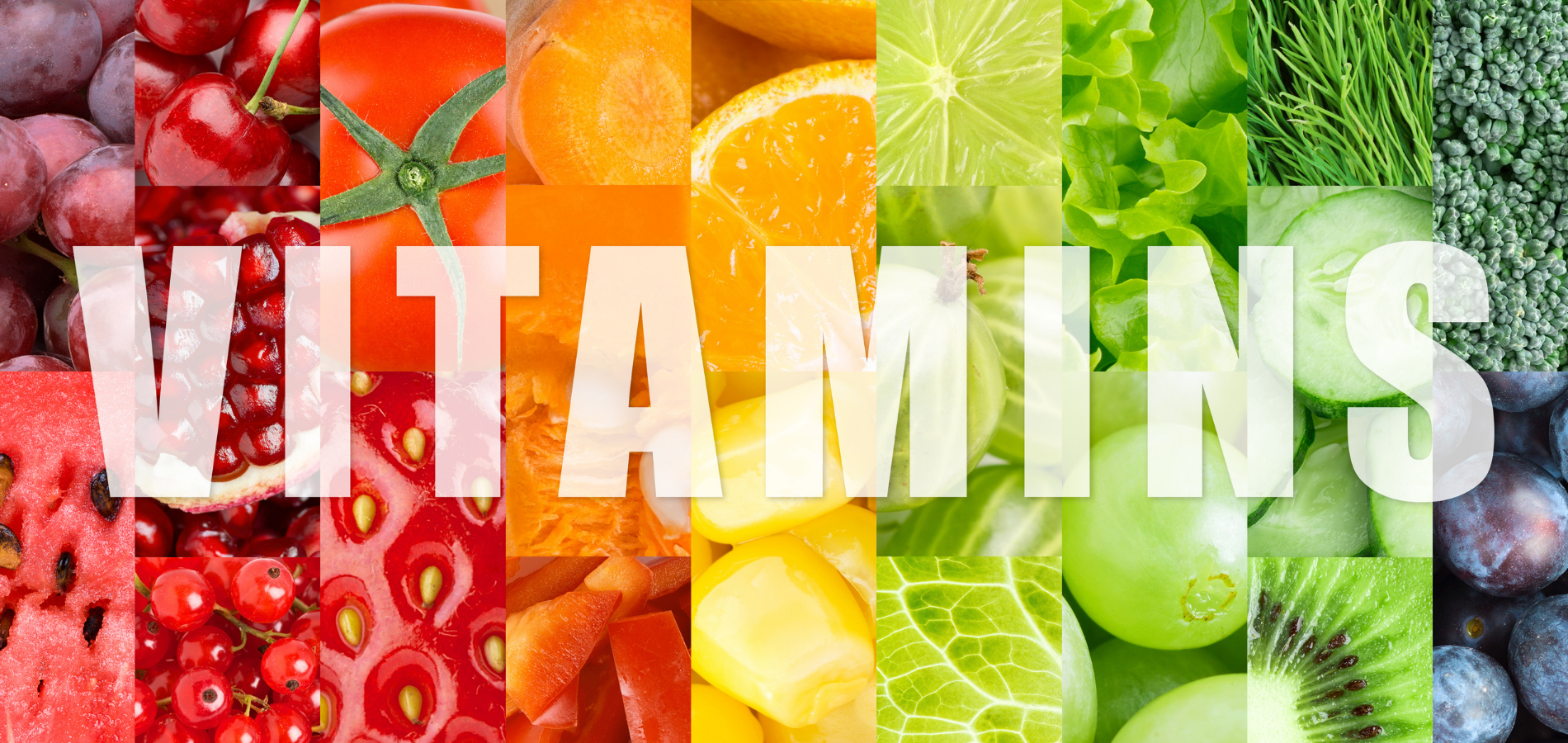Our micronutrients — vitamins and minerals — should always be taken into consideration when we are talking about eating for good health. Unfortunately, due to diet culture, it is one of the last things we worry about until we are forced to worry about it.
Vitamins are organic compounds that come from plants and animals. They are broken down with heat, acid or air. Minerals are inorganic compounds that come from soil or water. They can’t be broken down like vitamins. Vitamins are necessary for the body and needed for energy production, a healthy immune system, healthy bones and tissue.
In Part I, I discussed fat soluble vitamins, their importance, and how to get them through food. Now we will dive into water-soluble vitamins. Like I mentioned in Part I, water-soluble vitamins are absorbed quite easily by the body. Your kidneys remove excess water-soluble vitamins that aren’t needed. Because of this, you won’t store large amounts of these vitamins, and that is why you need to keep getting them from food to make sure you are getting what you need regularly. Make sure, if you haven’t already, to check out Part 1 for all the information you need on fat-soluble vitamins.
There are nine essential water-soluble vitamins, eight of which are part of the B complex. Here is a breakdown of each so you know the best food sources and what each does for your health.
Vitamin C
This essential vitamin that we all associate with oranges and is also called ascorbic acid helps with the immune system, controlling and preventing infections, and may help with healing wounds.
It is a powerful antioxidant that has the ability to counteract harmful free radicals, which are unstable molecules that can damage cells, and possibly cause illness and premature aging. Vitamin C is needed to help make collagen, which is a protein that acts as a building block in connective tissue that is in different systems and tissues in the body: nervous, immune, bone, cartilage and blood. Vitamin C can also help make some hormones and chemical messengers used in the brain and for our nerves.
Vitamin C improves the absorption of nonheme iron, the type of iron found in plant foods such as leafy greens and lentils.
It is fairly easy to get the daily vitamin C requirements because it is in many different fruits and vegetables, some of which you may have never realized. The highest amounts are in citrus fruits (oranges, grapefruits, and lemons), kiwi, guava, bell peppers, strawberries, papaya, brussel sprouts, and broccoli. Some others that are good but a bit lower in vitamin C are kale, potato, cabbage, and tomato.
The RDA (recommended daily allowance) for vitamin C is anywhere between 75 mg to 90 mg daily for men and 60 mg to 75 mg daily for women. For pregnant women, it’s 66 to 85 mg daily. These requirements can change depending on a few things like smoking, illness, and lactation.
The likelihood of getting too much is minimal but if your body is getting too much, you could experience diarrhea, heartburn, headache, and abdominal cramps.
B-complex vitamins
B-complex is a group of eight water-soluble vitamins that have very similar roles in the body.
Vitamins that make up the B-complex are thiamine (vitamin B1), riboflavin (vitamin B2), niacin (vitamin B3), pantothenic acid (vitamin B5), pyridoxine (vitamin B6), biotin (B7), folic acid (B9), and the cobalamins (vitamin B12).
In order to have optimal energy levels, brain function, immune function, eyesight, digestion, nerve function, hormone production, muscle skeletal health, and cardiovascular health, an appropriate level of B vitamins are required.
Deficiencies in certain B vitamins like folate, B6, and B12 are more common, but in general, those who are more at risk for deficiency in B vitamins are older adults, those with digestive issues, and pregnant women. Certain conditions, like Crohn’s disease, celiac disease, and alcohol overconsumption can stop the body from absorbing B vitamins, which can increase the risk of becoming deficient.
Even though they have similar roles, they do have specific functions and are not always found in the same food source.
So let’s talk about each of them so you have a better understanding of their benefits and sources.
Thiamine (B1)
B1 isn’t one you hear about often but it does have some key roles in the body. It enables our bodies to use carbohydrates for energy, is needed for glucose metabolism, and is also needed for healthy nerve, muscle, and heart function. Only a small amount is stored in the liver, so getting foods rich in thiamine daily is needed.
You can find it in the husks of grains (this is why cereal and bread manufacturers may enrich their products with B1), pork, beef, fish, legumes, sunflower seeds, cauliflower, liver, oranges, eggs, potatoes, asparagus, and kale. Other good sources include brewer’s yeast and blackstrap molasses.
The RDA for thiamin is 1.2 mg for males and 1.1 mg for females over the age of 18 years. Pregnant or breastfeeding women of any age should be getting 1.4 mg each day.
Riboflavin (B2)
Some bacteria in the gut can help make minimal amounts of riboflavin, but not really enough for what you need. It helps break down proteins, fats, and carbohydrates, which means it plays a very important role in our body’s energy supply.
B2 helps convert carbohydrates into adenosine triphosphate (ATP), energy-carrying molecules found in the cells of all living things. ATP takes energy from the breakdown of food and releases it for fuel in our muscles and other processes in the body.
Riboflavin also supports the production of healthy red blood cells and can act as an antioxidant, which can prevent damage from free radicals.
It can be found in beef, salmon, mushrooms, beef liver, tofu, dairy, almond, molasses, artichokes, asparagus, kelp, and eggs.
The RDA for B2 for men aged 19 years and over is 1.3 mg per day, and for women, it is 1.1 mg per day. During pregnancy, women should have 1.4 mg per day, and when breastfeeding, 1.6 mg per day.
Niacin (B3)
Niacin has many important roles in the body. It acts as a coenzyme, and 400 different enzymes rely on it for different processes. It also helps metabolize nutrients to be used as energy, creates cholesterol and fats, creates and repairs DNA, and has some antioxidant effects. Niacin helps with improving circulation, and may help diminish inflammation. Lastly, it has a part in helping the body make some sex and stress hormones.
The best food sources are, beets, brewer’s yeast, beef liver, beef kidney, most fish, sunflower seeds, peanuts, most meats, bananas, legumes, brown rice, and nuts.
The RDA for niacin for men 19 years and older is 16 mg; for women 19 years and older the RDA is 14 mg, for pregnant women, it is 18 mg, and for breastfeeding women, the RDA is 17 mg.
Pantothenic acid (B5)
B5 has a role in breaking down fatty acids by helping to make coenzyme A (CoA), the chemical compound that helps enzymes with fat metabolism. It also helps the body make blood cells. Panthenol, made from pantothenic acid, is often used in skin care and hair products to help moisturize.
Some food sources of B5 are dairy foods, eggs, potatoes, tomatoes, sunflower seeds, and avocado. Whole grains are another great source, but the processing of grains like rice and flour removes most of the pantothenic acid, because it’s found in the outer layer of grains.
The RDA for men and women 19 and over is 5 mg daily. For pregnant and lactating women, it increases to 6 to 7 mg daily.
Pyridoxine (B6)
B6 has an active coenzyme form called pyridoxal 5’ phosphate (PLP). It’s the most common form to measure as levels in the blood. PLP is actually a coenzyme that helps more than 100 enzymes with different functions in the body, including the breakdown of proteins, carbohydrates, and fats. It also helps the body maintain normal levels of homocysteine (an amino acid that at high levels can cause heart problems). B6 plays an important role in supporting a healthy immune system and helps regulate brain function and moods. It also helps maintain healthy nerve function.
Some food sources of B6 are fish like salmon, tuna, snapper, and mahi-mahi; tofu, chicken and turkey, bananas, meat, and there are very high amounts in pistachios.
The RDA for B6 for men ages 14–50 years is 1.3 mg daily, 51 and over is 1.7 mg daily. For women ages 14–18 years is 1.2 mg, 19–50 years is 1.3 mg, 51 and over is 1.5 mg. For pregnant and lactating women, the amount should increase to 1.9–2.0 mg daily.
Biotin
Biotin has an important role in the function of enzymes called carboxylases. These enzymes are involved in metabolic functions like the production of glucose and fatty acids. Biotin also plays a key role in gene regulation (the process used to control the timing, location, and amount in which genes are expressed) and cell signalling (the ability of a cell to receive, process, and transmit signals with its environment and with itself).
Some food sources are meat, fish, eggs and liver, with smaller amounts in legumes, nuts and seeds, sweet potatoes, mushrooms, bananas, broccoli, avocado and nutritional yeast.
Folate
Also known as folic acid, which is folate’s more absorbable form than that found in food sources. Folate has a role in breaking down homocysteine, an amino acid that can cause harm in the body if there are high amounts. It’s also involved in protein metabolism, is needed to help produce healthy red blood cells, and is absolutely necessary during rapid growth, like when a woman is pregnant, for fetal development. It can also be helpful in helping women in menopause with reducing hot flashes by affecting levels of norepinephrine and serotonin, which are neurotransmitters.
Some food sources are dark leafy greens, sunflower seeds, legumes, asparagus, beets, citrus fruits, wheat germ, and avocado,
The RDA for men and women ages 19 years and older should aim for 400 micrograms (mcg) DFE (dietary folate equivalents). Pregnant and lactating women require 600 mcg DFE and 500 mcg DFE. People who regularly drink alcohol should aim for at least 600 mcg DFE of folate daily since alcohol can impair absorption.
Cobalamins (B12)
B12 plays an important role in healthy nerve cells and helps with the production of DNA and RNA (genetic material). It binds to protein in the foods we eat, then when in the stomach, hydrochloric acid and some enzymes unbind it. After this, it binds to a protein called intrinsic factor so it can be absorbed in the small intestine. This is why protein levels are important in a healthy diet. B12 also works closely with folate/folic acid, to help make red blood cells and to help iron do its job better in the body.
Some food sources are eggs, fish, meat, dairy products, poultry, and nutritional yeast.
The RDA for B12 is 2.4 mcg daily for men and women ages 14 years and older. For pregnant and lactating women, the amount increases to 2.6–2.8 mcg daily.
If you eat a variety of foods, a deficiency is very unlikely, unless you have a condition that makes your body need more or inhibits assimilation. Over-consuming alcohol, poor digestion, lack of protein, lack of vegetables or certain medications can inhibit the amount of B vitamins we get and how much we assimilate.
As previously mentioned, water-soluble vitamins aren’t stored in the body or at least aren’t for long periods of time, so making sure we eat foods high in these vitamins is important for our health and many processes in the body.
Remember to check out Part 1 on fat-soluble vitamins so you have a complete outlook on the vitamins we need for our overall health.





